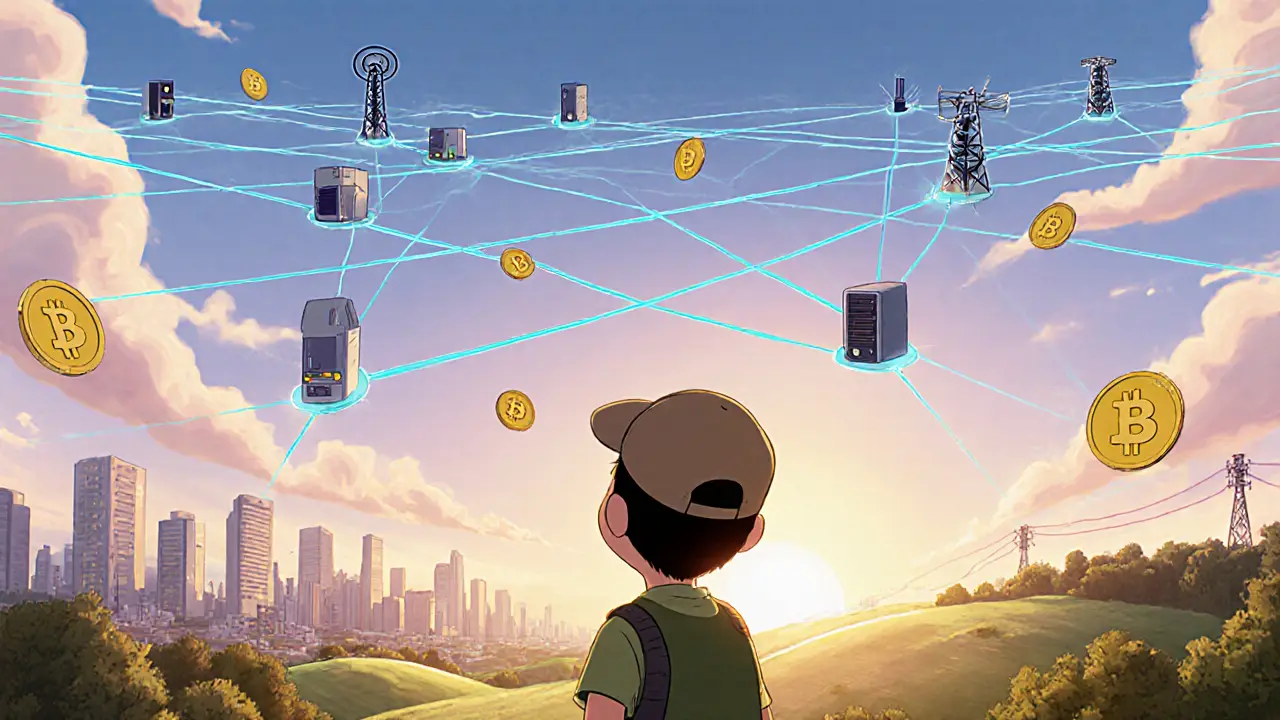DePIN ROI Calculator
ROI Calculator
Calculate your potential return on investment for DePIN node operations based on current market data.
DePIN Project Comparison
See how different DePIN projects compare in terms of revenue generation and token utility.
Helium
2024 Service Revenue: $28.3M
Reward Rate: 5-15% (hotspot rewards)
Buy-and-Burn: 0% (burn via transaction fees)
Filecoin
2024 Service Revenue: $12.7M (quarterly)
Reward Rate: 7-12% (storage pledge)
Buy-and-Burn: 20% of storage fees
IoTeX
2024 Service Revenue: $6.4M
Reward Rate: 10-20% (sensor staking)
Buy-and-Burn: 30% of service revenue
When we talk about DePIN is a decentralized physical infrastructure network that merges real-world assets with blockchain‑based token incentives, the first question is how those tokens actually create value. Unlike meme coins that live on pure speculation, DePIN tokens are tied to tangible services-wireless coverage, storage capacity, compute power, or environmental sensors. This article breaks down the economic engine behind those tokens, shows where the money comes from, and explains what investors and participants should watch before jumping in.
What makes DePIN tokenomics different?
Traditional crypto projects often issue a fixed supply of tokens, then hope demand rises on hype. DePIN adds a revenue stream: real customers pay for network services in fiat or stablecoins, and a portion of that cash flow is converted into the native token. That creates a feedback loop where token holders are also service providers, and the token’s price reflects both market sentiment and actual cash earnings.
Supply and distribution mechanics
Most DePIN projects follow a five‑bucket model:
- Network participants - 40‑50% of total supply, allocated as rewards for deploying hardware or staking.
- Team & advisors - 15‑20%, usually subject to a 3‑4‑year vesting schedule to keep founders aligned with long‑term growth.
- Treasury - 10‑15%, held for future ecosystem grants, partnerships, and emergency funds.
- Community incentives - 15‑20%, used for bounties, marketing pushes, and onboarding programs.
- Liquidity provision - a small slice (often 5%) reserved for market‑making on decentralized exchanges.
This spread keeps concentration low, which historically reduces price volatility. For example, Helium caps its validator rewards at 25% of total supply, keeping the remaining 75% in the hands of hotspot owners and community members.

Incentive structures that drive behavior
DePIN tokenomics reward three core actions:
- Staking - Participants lock tokens to secure the network and earn an annual percentage yield (APY) typically between 5% and 20%.
- Infrastructure provision - Deploying a hotspot, sensor, or compute node yields per‑unit rewards calibrated to the service’s market value. Helium’s hotspots, for instance, generate HNT based on the amount of verified data transferred.
- Governance participation - Token holders vote on protocol upgrades, fee schedules, and treasury disbursements. Many projects use quadratic voting or delegated voting to prevent whales from dominating decisions.
These incentives are tightly linked to real‑world revenue. Filecoin converts a portion of its storage contracts into FIL burn‑and‑buybacks, creating a deflationary pressure that mirrors the company’s $12.7million quarterly earnings.
Token utility beyond speculation
For a token to sustain value, it must have clear, non‑speculative uses:
- Payment for services - On Helium, 1HNT equals one data credit; on IoTeX, tokens pay for sensor data streams.
- Staking collateral - Providers must lock a minimum amount of tokens to become eligible for rewards, aligning interests.
- Governance rights - Voting power is proportional to holdings, allowing token owners to shape fee structures and network upgrades.
- Access to premium features - Some networks gate advanced analytics or higher‑speed lanes behind token ownership.
When these utilities are enforced on‑chain, transparency improves dramatically. Projects that publish burn‑and‑buyback events on the blockchain give investors a real‑time view of how much revenue is feeding back into token scarcity.
Market dynamics and performance benchmarks
DePIN tokens have shown lower volatility than the broader crypto market. A 2023 analysis by CoinMarketCap found that the average DePIN token moved 30‑40% less than the overall market, largely because cash‑flow‑driven tokens have a floor set by service revenue. Helium generated $28.3million in enterprise IoT revenues in Q22024, while its token price still outperformed the market by roughly 67% after adjusting for volatility.
Buy‑and‑burn mechanisms also tighten supply. IoTeX earmarks 30% of service revenue for weekly token buybacks, shaving 2.1% off the circulating supply each year. That deflationary pressure compounds when paired with growing demand for sensor data.

Risks and regulatory challenges
Despite the upside, DePIN projects face three major hurdles:
- Implementation complexity - Deploying hardware, ensuring uptime, and managing electricity costs require technical competence. New participants often cite configuration headaches and unpredictable demand as the top pain points.
- Regulatory uncertainty - Chainalysis reports that 78% of jurisdictions lack clear guidance on decentralized infrastructure. This can expose participants to unexpected licensing or tax obligations.
- Revenue verification - While on‑chain burns are transparent, some projects have overstated enterprise contracts. Delphi Digital warned that without audited financials, investors may be misled by inflated revenue claims.
Mitigation strategies include focusing on projects with third‑party audits, choosing networks that publish on‑chain proof of service (e.g., proof‑of‑coverage on Helium), and staying updated on local regulatory developments.
Future outlook and project comparison
Industry forecasts see the DePIN market growing from $4.7billion in 2023 to over $22billion by 2027, driven by IoT adoption, edge computing, and green‑energy monitoring. To help you decide where to allocate capital, here’s a quick side‑by‑side look at three leading tokens.
| Project | Supply Model | Reward Rate (APY) | Buy‑and‑Burn % of Revenue | 2024 Service Revenue (USD) |
|---|---|---|---|---|
| Helium | Dynamic cap, ~1billion HNT | 5‑15% (hotspot rewards) | 0% (burn via transaction fees) | $28.3M |
| Filecoin | Fixed 2billion FIL | 7‑12% (storage pledge) | 20% of storage fees | $12.7M (quarterly) |
| IoTeX | Fixed 1billion IOTX | 10‑20% (sensor staking) | 30% of service revenue | $6.4M |
Helium leads in network size, but its buy‑back mechanism is limited to transaction fee burns. Filecoin and IoTeX add stronger deflationary pressure through revenue‑linked buy‑backs, which can protect token price during market dips.
Practical checklist for aspiring participants
- Identify a project with transparent on‑chain revenue verification.
- Calculate hardware upfront cost vs. expected APY. Use a simple ROI formula: ROI = (Annual Token Rewards × Token Price) ÷ Hardware + Power Costs.
- Check local regulations: some regions classify hotspot operators as telecom service providers.
- Secure a reliable internet connection and power source; outages directly cut rewards.
- Stake the minimum required tokens to qualify for higher reward tiers.
- Engage with the community-Discord, Reddit, or Telegram-to get real‑time troubleshooting help.
Following this list can shave weeks off the learning curve and improve your chances of turning a modest hardware investment into a steady crypto income.
Frequently Asked Questions
How are DePIN tokens different from regular crypto tokens?
DePIN tokens are tied to real services-like wireless data, storage, or compute-so their value reflects both market demand and actual cash flow. Regular tokens often rely solely on speculation.
Do I need technical expertise to join a DePIN network?
Basic networking and hardware setup skills are enough for most hotspot or sensor projects. More complex nodes, like Render Network GPUs, require deeper knowledge of GPU drivers and electricity cost management.
What is a “buy‑and‑burn” mechanism?
A portion of the network’s fiat revenue is converted into the native token, which is then sent to an irrecoverable address (a “burn”). This reduces circulating supply and can support token price.
Are DePIN projects regulated?
Regulation varies by country. Most jurisdictions treat DePIN tokens as securities or utility tokens, but 67% of nations still lack specific rules, creating legal gray areas for operators.
How can I evaluate the profitability of a DePIN node?
Start with the hardware cost, estimate electricity usage, and plug those numbers into the ROI formula mentioned earlier. Then compare the projected token earnings (using current token price) to your total annual expense.


Comments
Wow, this deep dive really shines a light on how DePIN tokenomics differ from the usual hype‑driven crypto projects. The way you dissect the revenue‑backed token model feels like pulling back a curtain on a stage that’s been shrouded in mystery. I love how you connect real‑world services like wireless coverage and storage to tangible token value – that’s the drama that keeps the community engaged! 🎭
For newcomers, the checklist you provided at the end is pure gold. It gives a clear roadmap without drowning them in jargon. Also, the comparison table makes it easy to see where each project stands in terms of supply, APY, and buy‑back mechanisms. Keep the insightful posts coming, they’re the lifeblood of this subreddit!
Great summary, thanks for the breakdown.
Alright, let’s unpack the token economics a bit more because there’s a lot to digest here.
First, the five‑bucket supply model is a clever way to keep token distribution relatively decentralized while still rewarding the actual infrastructure providers. By allocating 40‑50% to network participants, projects ensure that the people who are physically deploying hardware get the lion’s share of the upside.
Second, the team and advisor vesting schedules (usually 3‑4 years) serve as a safeguard against sudden dumps that could destabilize the market. It aligns long‑term incentives and keeps the community’s trust intact.
Third, the treasury portion (10‑15%) is essential for funding future grants, partnerships, and emergency liquidity – think of it as a financial safety net that can be tapped without compromising the token’s core value proposition.
When you look at the incentive structures, the three core actions – staking, infrastructure provision, and governance – all have direct economic feedback loops. Staking yields a predictable APY (5‑20% depending on the project) which is paid out of the real cash flow from customers using the network services. This makes the yield more sustainable than a purely inflationary reward.
Infrastructure provision rewards are calibrated to market demand. For instance, Helium hotspots earn HNT based on verified data transferred, while Filecoin miners earn FIL proportional to storage contracts they fulfill. That means your earnings scale with actual usage, not just token price speculation.
Governance participation, especially with quadratic or delegated voting models, helps prevent whales from dominating decisions, fostering a healthier ecosystem.
On the utility side, tokens aren’t just speculative assets; they’re used to pay for services, act as staking collateral, grant governance rights, and even unlock premium features. This multi‑dimensional utility creates a floor for demand because users need the token to interact with the network.
Buy‑and‑burn mechanisms further tighten supply. IoTeX, for example, burns 30% of its service revenue each week, which progressively reduces circulating supply and can support token price during bear markets.
Risk factors are still present, though. Implementation complexity can be a barrier for hobbyists – the hardware setup, power costs, and maintenance can eat into profits if not managed carefully. Regulatory uncertainty is another wild card; many jurisdictions haven’t clarified how DePIN operators should be classified, which can lead to unexpected licensing or tax obligations.
Revenue verification is critical. Projects that publish on‑chain proofs of coverage (like Helium) or have third‑party audits provide greater transparency and reduce the risk of inflated claims.
Finally, the market outlook is bullish – forecasts suggest the DePIN sector could grow from $4.7 B in 2023 to over $22 B by 2027, driven by IoT, edge computing, and green‑energy monitoring. For investors, that means there’s substantial upside if you pick projects with solid fundamentals and transparent economics.
All in all, the article does a solid job of laying out the mechanics, risks, and opportunities. Use the ROI calculator to crunch your numbers, but always do your own due diligence before committing capital.